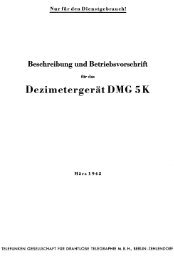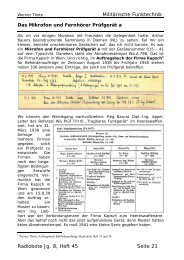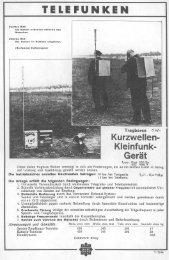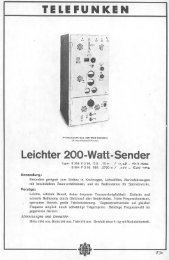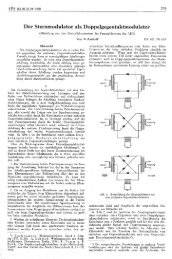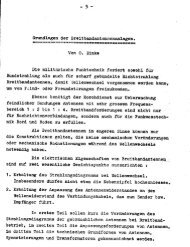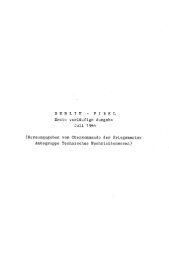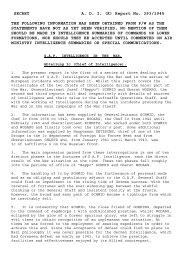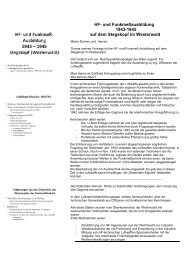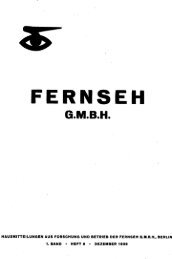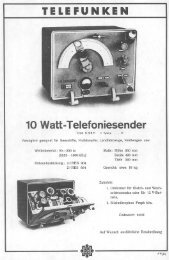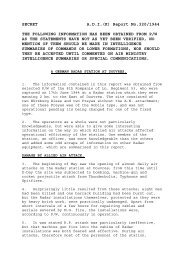SECRET A. D. I. (K) Report No. 357/1945. THE ... - Cdvandt.org
SECRET A. D. I. (K) Report No. 357/1945. THE ... - Cdvandt.org
SECRET A. D. I. (K) Report No. 357/1945. THE ... - Cdvandt.org
You also want an ePaper? Increase the reach of your titles
YUMPU automatically turns print PDFs into web optimized ePapers that Google loves.
9. The fear of the Allied countermeasures was much to the fore during the last two years and<br />
considerable research and efforts was devoted to offsetting such interference and to perfecting<br />
systems which would reduce and if possible preclude the danger of jamming. Another factor<br />
always present in the minds of those responsible for tactical navigational requirements was that<br />
the apparatus must be as light and small as possible because of the limited space available in<br />
German aircraft.<br />
10. During the last stages of the war, and as a natural consequence of German air policy, being<br />
forced to concentrate on the defensive, thereby involving almost exclusive use of fighter power,<br />
a great deal of attention was devoted to the development of simple navigational aids suitable<br />
for single-engine aircraft of which Rübezahl was a typical example.<br />
D/F LOOP EQUIPMENT.<br />
PeGe (Peil Gerät) 6.<br />
11. PeGe 6 was the successor of PeGe 5, the standard loop D/F, set in use at the beginning of<br />
the war, and. operated on 150 - 1200 kc/s (2000-250 meters). It provided automatic D/F<br />
facilities, the W/T operator merely having to tune to the signal and the "answer" being produced<br />
on a course indicator.<br />
12. In the opinion of P/W, who was responsible for operational requirements in the<br />
navigational field and who had had fairly extensive navigational experience with K.G.40,<br />
PeGe 6 was less reliable than the manually-operated PeGe 5 as the automatic D/F facilities<br />
could not distinguish between the true signal and jamming and were apt to record bearing midway<br />
between the two if they were near together. The human ear was much more acute and<br />
could distinguish the minimum of the real signal from that of the "phoney” one. It had the<br />
further disadvantage that it was a heavier piece of equipment than the manually operated set.<br />
FuGe 141<br />
13. The FuGe 141 operating on a frequency band of 58.0 - 59.2 mc/s was a receiver with a D/F<br />
loop fitted to Air Rescue aircraft used for homing on to the NS 4 emergency radio set carried on<br />
the chest by pilots.<br />
14. The NS 4 had a flexible steel tape aerial and batteries which gave it an endurance of 2 to<br />
2,5 hours.<br />
FuGe 142.<br />
15. The FuGe 142 using the 2000 - 250 metre band was a small D/F battery set for use in<br />
emergency in the event of failure of the aircraft' s electricity supply.<br />
16. The FuGe 142 had a manually-operated loop and its accuracy was only 10° to 15°.<br />
17. When the P/W who, in October 1944, took over the navigational tactical requirements first<br />
made its acquaintance, he discovered that the designer of the emergency set, while having the<br />
laudable object of assisting a crew in dire emergency when they where probably well and truly<br />
lost, had omitted to include any sensing arrangement. The set was, therefore, quickly scrapped<br />
as being as much of a danger as an aid.



